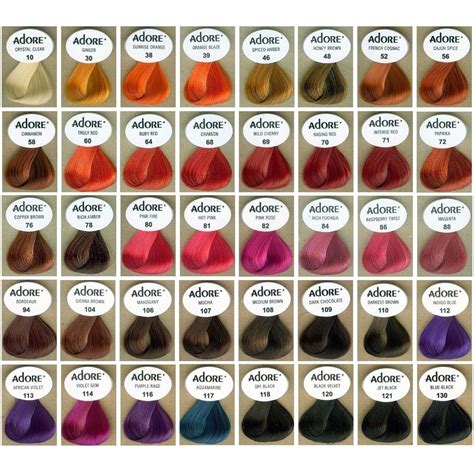Introduction
Colors play a profound role in our lives, evoking emotions, influencing perceptions, and shaping design decisions. Whether you’re a professional designer or simply someone who loves to express their creativity through color, understanding color theory is essential. The Adore Color Chart serves as a valuable tool for exploring the vast spectrum of colors and their harmonious combinations.

The Adore Color Wheel: A Spectrum of Possibilities
The Adore Color Wheel is a circular representation of the primary, secondary, and tertiary colors.
Primary Colors:
- Red
- Yellow
- Blue
Secondary Colors:
- Green (Yellow + Blue)
- Orange (Red + Yellow)
- Violet (Red + Blue)
Tertiary Colors:
- Blue-Green
- Yellow-Green
- Red-Orange
- Red-Violet
- Blue-Violet
- Yellow-Orange
The arrangement of these colors on the wheel allows us to identify complementary colors that lie opposite each other, analogous colors that are adjacent, and triadic colors that form an equilateral triangle on the wheel.
Harmony and Contrast: Creating Visual Impact
Color harmony refers to the pleasing combination of colors that create a sense of balance and unity. The Adore Color Chart provides various color harmony schemes:
- Monochromatic: Shades of the same base color.
- Analogous: Adjacent colors on the wheel, creating a cohesive flow.
- Complementary: Colors opposite each other on the wheel, resulting in high contrast.
- Triadic: A combination of three colors equidistant on the wheel, producing a vibrant and balanced effect.
In contrast, contrasting color combinations can emphasize specific elements or create visual excitement:
- Warm vs. Cool: Warm colors (red, orange, yellow) evoke a sense of warmth and energy, while cool colors (blue, green, violet) convey a sense of calm and serenity.
- Light vs. Dark: Lighter shades create a sense of space and airiness, while darker shades add depth and richness.
- Saturated vs. Unsaturated: Saturated colors are intense and vibrant, while unsaturated colors are more subtle and muted.
Applications of the Adore Color Chart
The Adore Color Chart finds applications in numerous fields, including:
- Interior Design: Choosing paint colors, furniture, and décor that create a harmonious and inviting space.
- Fashion Design: Coordinating fabrics and accessories to create flattering and stylish outfits.
- Web Design: Selecting colors for website backgrounds, text, and graphics to enhance usability and aesthetics.
- Branding and Marketing: Using color to establish a distinct brand identity and connect with target audiences.
- Fine Arts: Creating paintings, sculptures, and other artworks that convey emotion and inspire imagination.
Tips and Tricks for Using the Adore Color Chart
- Consider the purpose of your design: Determine the desired mood and target audience before choosing colors.
- Experiment with different color schemes: Use the Adore Color Wheel to explore various harmonies and contrasts.
- Use color psychology: Understand the emotional impact of different colors and use them strategically.
- Pay attention to saturation and brightness: Adjust the intensity and lightness of colors to create different effects.
- Test your colors in various lighting: Colors can appear differently under different lighting conditions.
Pros and Cons of the Adore Color Chart
Pros:
- Comprehensive and well-organized.
- Provides a wide range of color combinations.
- Easy to use and understand.
Cons:
- Does not account for cultural differences in color perception.
- Limited guidance on color usage in specific contexts.
Conclusion
The Adore Color Chart is an indispensable tool for anyone interested in exploring and understanding the world of color. By mastering its principles, you can create visually appealing designs, harness the power of color psychology, and express your creativity in countless ways. Embrace the spectrum of colors and unlock the possibilities that await within the Adore Color Chart.
Additional Resources
- The Art of Color Combination
- Color Theory for Designers
- The Little Book of Color: How to Use Color to Transform Your Mood, Space, and Style
